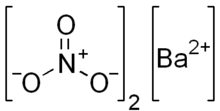Barium Nitrate also known as Nitrobarite, Barium Dinitrate, or Barium Salt is an inorganic substance and is similar to the other barium salts. It is colourless, poisonous, and water-soluble.
Index
Structure & Formula
Barium Nitrate formula is written as Ba(NO3)2. The structure of the substance is made up of one barium cation Ba2+ and two nitrate anions NO3–. The cubic crystal structure has one barium cation surrounded by two nitrate anions.

Preparation of Barium Nitrate
The preparation of this substance can be done in two main processes.
1. Using Carbonate
First, dissolve barium carbonate (BaCO3) in nitric acid (HNO3). Iron impurities precipitate to the surface as the two chemicals react. These impurities must be removed using the filtering technique. The leftover mixture must then be evaporated. Finally, after crystallization, we have pure barium nitrate, which is often used in industry.
2. By Combining Barium Sulfide with Nitric Acid
We can also prepare this substance by combining barium sulfide (BaS) and nitric acid (HNO3).
Properties of Barium Nitrate
Now, let’s move on to the discussion of the properties of this compound which implies physical properties and chemical properties.
Physical Properties
| Barium Nitrate Formula | Ba(NO3)2 |
| IUPAC Name | barium(2+);dinitrate |
| Molecular Weight | 261.333 g/mol |
| Melting Point | 590°C |
| Density | 3.24 g/cm3 |
| Solubility in Water | At 20°C, the solubility in water is 8.7 g/100ml (moderate) |
| Refractive Index | 1.5659 |
Chemical Properties
- It is a strong oxidant.
- Ba(NO3)2 decomposes to barium oxide (BaO) at higher temperatures:
2Ba(NO3)2 → 2BaO + 4NO2 + O2 - It is water-soluble.
Applications
- The green colour during fireworks and flares is produced by Barium Nitrate (It produces green flames).
- Other barium compounds can be synthesized using barium dinitrate.
- It is also used in the production of high-quality, low-thermal-expansion glass. The oxygen in barium dinitrate helps to keep glass clear and discoloured. In addition, it is utilized in the production of optical glass. It raises the refractive index of glass, which is employed in goods like camera lenses.
- It is used in the military for signal flares in the field as it helps to the formation of a tiny pyrotechnic charge in the bullet’s base.
- In the manufacturing of BaO-containing products, barium dinitrate is used.
- The paints on your house’s walls are essentially a mixture of different chemical components. One of these chemicals is barium dinitrate. Notably, most paints would not exist without this specific substance because it is frequently used as a major ingredient.
- This substance is also an effective rodenticide. Leaving it out in the open at your house will keep rodents like mice and rats from entering or staying inside.
- Because of its high nitrate concentration, it is used to make grenades and other explosives.
Precautions
- Ingestion or inhalation of this substance is hazardous.
- Direct contact with the eyes and skin can potentially cause a number of harmful symptoms.
- Some of the symptoms of barium salt poisoning include upper lung inflammation, skin irritation, and eye irritation.
- Excessive salivation, colic, convulsive tremors, high blood pressure, vomiting, diarrhoea, and a strong pulse are all symptoms of swallowing.
- Hypokalaemia might result after exposure. This might result in cardiac and muscle problems. Death might result from exposure.
FAQs
Barium dinitrate, like almost all other nitrates, is soluble in water. This is due to the nitrate ions’ capacity to create hydrogen bonds with water.
The polar nitrate ions and the barium ions are both attracted to the polar water molecules, but the nitrate is more essential here: another barium salt, barium sulfate (BaSO4), is actually extremely insoluble due to the sulfates.
The chloride ion may form a precipitate with metals (silver, lead, mercury, and to a lesser extent copper) and provide a false positive result, whereas nitrates are always soluble.
When magnesium is burned at high temperatures with pure barium nitrate, the latter decomposes to barium oxide, nitrogen dioxide, and oxygen.
2Ba(NO3)2 → 2BaO + 4NO2 + O2.
At high temperatures, the generated NO2 and oxygen may rapidly oxidize heated magnesium metal to its oxide.
4Mg + 2NO2 → 4MgO + N2
2Mg + O2 → 2MgO
The residue would mostly consist of MgO and BaO.
More Compounds
